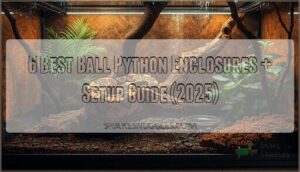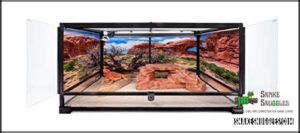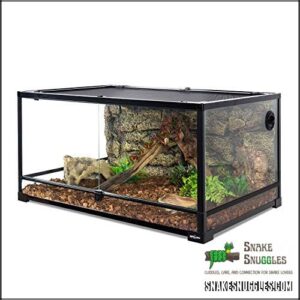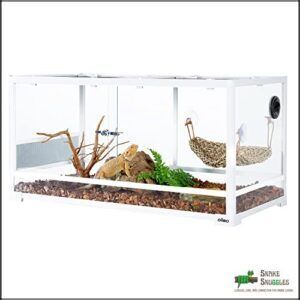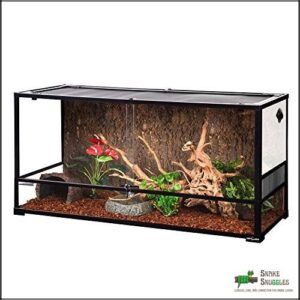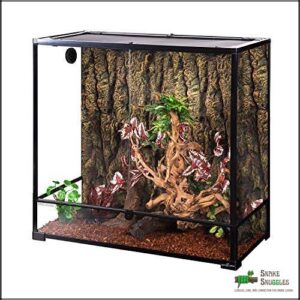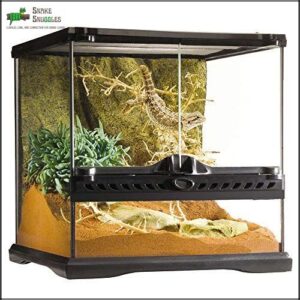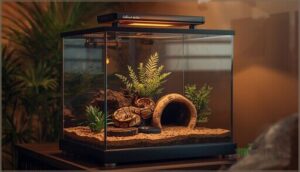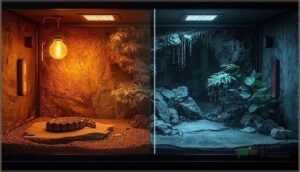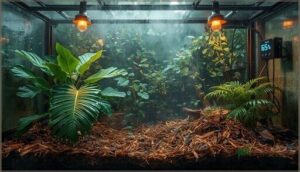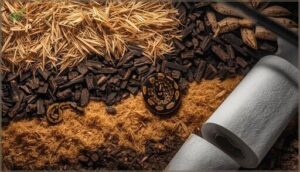This site is supported by our readers. We may earn a commission, at no cost to you, if you purchase through links.
Crack the lid on a ball python enclosure that’s too small, and your snake might as well vanish into its hide—stressed, cramped, and robbed of those natural behaviors keepers love to watch. A good habitat doesn’t just keep a python contained; it unlocks a world where your shy friend can stretch, explore, and thrive.
Choosing the best ball python enclosure changes everything: stable warmth, just-right humidity, the promise of safety in secure doors and cozy hides. Get these details right, and you’ll see more than a snake that survives—you’ll witness one that settles in, curious and bold, ready to show its best side.
Table Of Contents
- Key Takeaways
- Top 6 Best Ball Python Enclosures
- Choosing The Ideal Enclosure Size
- Essential Features for Ball Python Enclosures
- Setting Up The Perfect Ball Python Habitat
- Maintenance and Care Tips for Enclosure Health
- Frequently Asked Questions (FAQs)
- What type of enclosure is best for a ball python?
- Is a 40 gallon tank big enough for a ball python?
- How big should a cage be for a ball python?
- Is a 75 gallon tank good for a ball python?
- How often should I clean my ball pythons enclosure?
- Can multiple ball pythons be housed in one enclosure?
- What lighting schedule is best for ball pythons?
- Are bioactive setups suitable for ball python enclosures?
- How do I introduce my ball python to a new enclosure?
- Can ball pythons live together in one enclosure?
- Conclusion
Key Takeaways
- A proper ball python enclosure needs at least 4x2x2 feet (65-75 gallons) for adults, with floor space mattering far more than height since these snakes are primarily terrestrial and need room to stretch their full body length.
- Front-opening doors with secure locks reduce handling stress and prevent escapes better than top-opening lids, while 10-20% screen ventilation on top balances airflow with the 60-70% humidity ball pythons require.
- Glass enclosures offer durability and visibility but may need partial mesh covering to hold humidity, whereas PVC enclosures excel at heat and moisture retention with less modification needed.
- Daily spot-cleaning, a proper thermal gradient (88-92°F warm side, 76-80°F cool side), multiple hides, and moisture-retentive substrates like coconut fiber directly support your snake’s health and natural behaviors.
Top 6 Best Ball Python Enclosures
Choosing the right enclosure for your ball python can feel overwhelming with so many options on the market. Each terrarium offers different features like size, ventilation, and door styles that affect how well it meets your snake’s needs.
Here are six top-rated enclosures that provide the space, security, and functionality your ball python requires to thrive.
1. Carolina Custom Cages Large Terrarium
The Carolina Custom Cages Large Terrarium delivers the floor space your ball python needs—48 inches long by 24 inches wide—in a sturdy all-glass construction that won’t scratch or cloud over time.
You’ll appreciate the front sliding doors with key-lock security that prevent escapes while making feeding and cleaning straightforward. Assembly is uncomplicated, thanks to clear guides and double-boxed shipping that protects the glass panels.
The full steel mesh top provides excellent ventilation and accommodates overhead heating fixtures, though you may need to partially cover it to maintain ideal humidity levels for your snake.
Best For: Ball python keepers who want a spacious, durable glass enclosure with easy front access and enough floor space to meet or exceed adult snake requirements.
- 48×24-inch floor provides 8 square feet of space—well above the typical 4–6 square foot minimum for adult ball pythons—allowing room for multiple hides, water bowls, and enrichment items.
- All-glass construction resists scratching and maintains clear visibility over years of use, while the front sliding doors make daily maintenance easier than top-opening designs.
- Steel mesh top supports overhead heating and UVB fixtures securely, and the waterproof base tray (approximately 4 inches deep) contains spills and holds several inches of substrate without leaking.
- High ventilation from the full mesh top may require partial covering with foil or plastic to maintain the 50–70% humidity range ball pythons prefer, adding a step to initial setup.
- Key-lock mechanism can feel loose according to some users, which may prompt you to add a secondary latch if escape-proofing is a priority in your household.
- Price starts around $279.99 for the 48x24x18 model—reasonable for a large glass terrarium, but notably higher than plastic tub setups or smaller entry-level enclosures.
2. REPTI ZOO Glass Reptile Terrarium
If size suitability matters, the REPTI ZOO Large Reptile Terrarium offers 67 gallons spread across 36 by 24 by 18 inches—plenty of room for an adult ball python to stretch and explore.
This glass terrarium features front-opening doors with dual locks that address common security flaws and screen ventilation across the top for reliable airflow.
Assembly challenges are minimal thanks to the knock-down design, which fits together in about five minutes. Material durability stands out with tempered glass and an aluminum frame that resists scratches and maintains clarity through years of terrarium setup adjustments.
Best For: Reptile owners who need a spacious, secure enclosure for adult ball pythons or bearded dragons and want easy assembly with reliable ventilation.
- 67-gallon capacity with 36 x 24 x 18 inch dimensions gives adult reptiles plenty of space to move and explore comfortably.
- Dual locking front doors and secure screen top prevent escapes while allowing easy access for feeding and maintenance.
- Quick knock-down assembly takes about five minutes, and the tempered glass with aluminum frame holds up well over time.
- Some customers received units with missing parts or shipping damage that required replacements.
- Stability concerns came up in reviews, with a few users needing to add extra support for heavy decorations.
- Not built for aquatic setups, so if you’re housing turtles or semi-aquatic species, you’ll need a different tank.
3. Oiibo White Reptile Terrarium Tank
Looking for more floor space without breaking the bank? The OIIBO Reptile Terrarium delivers 36 gallons with a clean white trim that blends into modern homes better than most ball python enclosures.
You’ll appreciate the double front doors with integrated locks that shut down security concerns, while mesh ventilation keeps air moving without drying out your terrarium setup. Material durability shines through tempered glass panels and a raised waterproof base designed for under-tank heaters.
Assembly challenges? Minimal—most owners report completing terrarium setup in under ten minutes with the included tools and gloves.
Best For: Reptile owners who want a spacious, secure enclosure with modern aesthetics and quick setup for ball pythons, bearded dragons, or other medium-sized reptiles.
- Double front doors with integrated locks provide secure, escape-proof access for handling and maintenance
- Quick assembly in under 10 minutes with included tools and gloves makes setup hassle-free
- Raised waterproof base with side wire openings safely accommodates under-tank heaters and equipment
- Some users report durability issues with locks and potential glass base cracks over time
- Open mesh panels on sides may require modifications like taping to maintain higher humidity levels
- Assembly instructions lack clarity and handling large glass panels alone can be challenging
4. REPTI ZOO Large Reptile Terrarium Tank
Need more room for your adult ball python? The REPTI ZOO Large Reptile Terrarium Tank offers 67-gallon or 120-gallon models with premium tempered glass durability that holds up through years of daily maintenance.
Front-opening doors with secure locks deliver escape prevention while making feeding routines simple. Screen ventilation effectiveness keeps air moving without sacrificing humidity control—you’ll maintain proper moisture levels even for tropical setups.
Assembly issues? Rarely reported, with most owners finishing setup in under ten minutes. This glass terrarium’s habitat flexibility accommodates everything from climbing branches to large water bowls without crowding your snake.
Best For: Owners of large adult ball pythons, bearded dragons, or similar reptiles who want a spacious, secure, and easy-to-maintain glass terrarium.
- Spacious 360° full-view design with secure front sliding doors for easy access and observation.
- Durable tempered glass construction supports long-term use and regular cleaning.
- Superior ventilation system maintains humidity for tropical species while preventing escapes.
- Occasional reports of assembly issues or cracked glass during delivery.
- Higher price point compared to similar glass terrariums.
- Mesh top can be vulnerable to burning from high-wattage lighting if not monitored.
5. REPTI ZOO Large Reptile Terrarium
For keepers aiming to hit every note on ball python enclosure care, the REPTI ZOO Large Reptile Terrarium features a raised frame that accommodates substrate heaters for spot-on humidity control and terrarium lighting. Its all-glass walls excel at showcasing reptile behavior.
Front-opening doors with locks boost snake enrichment and simplify tank maintenance—no scrambling from above.
Spacious inside, this glass terrarium’s clever airflow and ample floor plan easily match expert dimensions, giving your ball python the room and comfort most guides recommend.
Best For: Keepers who want a roomy, secure, and visually clear enclosure that meets or exceeds modern ball python care recommendations.
- Spacious 48″x24″x24″ all-glass design with front-opening, lockable doors for easy access and safe handling.
- Raised base fits substrate heaters for reliable humidity and temperature gradients.
- Wire mesh top and glass sides balance airflow and moisture, supporting both desert and rainforest setups.
- Assembly can be tricky, and fragile glass panels may arrive with scratches or damage.
- Some users report occasional leakage or plastic part issues.
- Heavy (about 80 lbs) and may need extra support or two people to move safely.
6. Exo Terra Reptile Glass Terrarium Kit
An Exo Terra Outback glass terrarium stands out for its blend of smart ventilation efficiency and solid glass terrarium benefits. Screen ventilation on top encourages healthy airflow, while humidity management is made simple, thanks to a raised frame and waterproof base.
Front-opening doors with secure locks set you up for easy maintenance—no wrestling with awkward lids here.
Market value holds strong, with these kits often ranking among the most recommended for ball pythons. It’s a practical, secure choice that delivers both comfort and flexibility.
Best For: Anyone needing a sturdy, easy-access terrarium for small reptiles or amphibians—especially great for ball pythons, geckos, and frogs.
- Dual front-opening doors with lock make cleaning and feeding simple and secure.
- Raised frame and screen top support both under-tank heaters and healthy airflow.
- Highly rated by reptile owners; keeps strong resale value over time.
- Can be heavy and tough to move once set up.
- Styrofoam background isn’t durable for all pets or décor styles.
- May require extra accessories to hold humidity for tropical species.
Choosing The Ideal Enclosure Size
Finding the right size home for your ball python is one of the most important choices you’ll make. Whether you’re setting up for a young snake or a full-grown adult, you’ll want an enclosure that meets their space and comfort needs.
Here are the key size options to keep in mind next.
Minimum Size Recommendations for Adults
Regarding adult ball python enclosure size, think big—a 4x2x2-foot tank (about 65-75 gallons) isn’t just preferred, it’s now the leading ideal among ethical breeders and specialists.
Ensuring a spacious habitat allows for natural behaviors to flourish. Using the minimum dimensions ensures proper space utilization, reduces stress, and fosters healthy behaviors.
Enclosure upgrades beyond this—especially for larger females—reflect evolving breeder standards and a deeper respect for animal welfare.
Hatchling and Juvenile Enclosure Dimensions
Wondering how to pick the right ball python enclosure size for a growing snake? Hatchlings and juveniles thrive when you match spatial needs with their growth milestones. Start with these essentials:
- Minimum dimensions: 20 x 11 x 13 inches for hatchlings
- Juveniles: at least 24 x 12 x 12 inches
- Substrate depth: 1–2 inches for humidity
- Security features: snug hides and escape-proof doors
For adults, consider that larger enclosures are generally recommended.
Benefits of Larger Enclosures
Think of a larger enclosure as an open door to a world of natural behavior and mental stimulation for your adult ball python. More floor space lets your snake stretch, climb, and explore—boosting behavioral diversity, physical health, and mental wellbeing.
With room to roam and better environmental control, you support ideal ball python health and energize everyday snake behavior.
Floor Space Vs. Height Considerations
Regarding Ball Python Enclosure Sizes, floor space trumps height every time. Sufficient floor space facilitates natural movement, thermoregulation efficiency, and reduces stress—while vertical enrichment needs are modest for these mostly terrestrial, semiarboreal snakes.
Recommended dimensions mean at least 8 square feet of enclosure floor space, with heights of 18–24 inches for appropriate terrarium dimensions and behavioral impact.
Essential Features for Ball Python Enclosures
When you’re sizing up options for your ball python’s home, it helps to know what features actually make a difference with daily care and safety.
Some details can seem small, but they matter a lot over time for both you and your snake.
Here’s what to look for as you compare the best enclosures on the market.
Front-Opening and Lockable Doors
A front-opening door isn’t just about convenience—it’s a game changer for escape prevention and handling stress. Sliding doors or hinged doors with key-lock security outshine lid locks, making daily husbandry efficient and safe. You’ll also meet modern design standards, giving your python a secure, comfortable home.
- Reduces escape risk with secure locking mechanisms
- Minimizes stress during handling and cleaning
- Meets professional enclosure design standards
Screen Ventilation and Airflow
Great doors make life easy, but screen ventilation keeps your snake thriving. Proper vent placement means humidity control isn’t a guessing game, and well-designed airflow brings stable temperatures while helping ward off respiratory problems. Smart ventilation covers 10–20% of the top, balancing air and moisture day and night.
| Feeling Secure | Breathing Easy |
|---|---|
| Locked doors prevent escapes | Ventilation aids snake health |
| Stable temps relax the snake | Airflow protects against illness |
Raised Frames for Substrate Heaters
Heat and airflow go hand in hand, especially under a ball python enclosure. Raised frames create a small gap beneath the terrarium, perfect for substrate heaters. This smart design helps you prevent overheating, improve airflow, and keep substrate temperatures stable.
With:
- Overheating prevention
- Reliable thermostat integration
- Smoother substrate effects
- Choices in design variations
your tank setup runs safer and smarter.
Durable Construction Materials (Glass, PVC, Wood)
Choosing a ball python enclosure means weighing Glass Durability against Material Heat Retention and Wood Rot Resistance. Glass enclosures are sturdy but heavier, while wood, though warm, needs frequent sealing.
PVC enclosures outshine for waterproofing, making maintenance simple and humidity control a breeze. Your enclosure material considerations should balance durable materials, weight comparison, and the safety needs of your snake.
Setting Up The Perfect Ball Python Habitat
Picking the right home is the first big step to happy, healthy ball python care. There are several standout enclosures on the market, each with its own strengths.
Here’s a closer look at some of the best options available right now.
Creating a Thermal Gradient (Warm and Cool Sides)
Think of your ball python’s enclosure as a landscape with sunny hills and shady valleys—this is your temperature gradient. To create it, focus on:
- Placing heating options like halogen bulbs on one end for a basking area
- Using a large enclosure size for gradient stability
- Monitoring temperatures with digital thermometers
- Keeping the warm side at 88–92°F, cool side 76–80°F
- Regulating heat sources to prevent health implications
Maintaining Optimal Humidity Levels
If you’ve ever tried to keep a desert plant happy in a bathroom, you know managing humidity is a balancing act. For Ball Python Care Requirements, regularly monitor humidity levels (aim for 60–70%) with digital hygrometers placed mid-enclosure. Integrate humid hides and adapt your Enclosure Design. Proper Substrate Selection and smart Humidity Monitoring help guarantee health and prevent common shedding issues.
| Core Topic | Practical Application |
|---|---|
| Humidity Monitoring | Use digital hygrometers, calibrate weekly |
| Enclosure Design | Cover part of screens for better retention |
| Substrate Selection | Coconut husk or cypress help lock humidity |
| Health Implications | Low humidity causes incomplete sheds |
Substrate Choices for Comfort and Cleanliness
While you weigh your options, remember that substrate depth matters for both burrowing behavior and odor control. Coconut fiber, cypress mulch, and blends like ReptiSoil offer comfort, humidity level support, and enrichment opportunities. Paper towels simplify cleaning but lack natural enrichment.
Consistent spot cleaning, guided by sanitation metrics, helps prevent mold and keeps your ball python’s home fresh and healthy.
Hides, Water Bowls, and Habitat Decor
A ball python’s health and sense of security hinge on thoughtful habitat setup. Here’s what makes the difference:
- Choose cave hides with Hide Material Safety in mind—PVC or resin keep stress down.
- Size your water bowl for soaking; Water Bowl Size matters for hydration.
- Mix up decor texture and try Enrichment Rotation.
- Branches and cage accessories encourage movement, aiding Stress Reduction.
Maintenance and Care Tips for Enclosure Health
Keeping your ball python’s enclosure in top shape is simpler when you know what to look for. A little routine care makes all the difference for your snake’s health and peace of mind.
Here’s what to keep in mind as you choose the best setup.
Cleaning and Spot Maintenance Schedule
Spotcleaned enclosures are the backbone of python hygiene. Waste removal should happen daily to prevent odor and bacteria. Inspect and clean the water bowl every day.
Deepcleaned routines, using F10SC or a diluted bleach solution, should follow every 2–4 weeks. Regular disinfection protocols and careful substrate health checks keep pathogens at bay, directly improving your snake’s well-being and enclosure odor control.
Managing Humidity and Temperature Fluctuations
Think of your python’s habitat like a finely tuned instrument—small shifts in humidity or temperature can throw the whole system off-key. Stable humidity levels (60–80%) and a steady temperature gradient are essential for health.
Use these essentials:
- Moisture-retentive substrates and humid hides
- Thermostat use benefits for safe heating
- Digital Temperature Monitoring Tools
- Covering mesh tops for Humidity Stabilization Methods
Preventing Escape and Ensuring Safety
When humidity and heat are balanced, snakes usually rest. But a ball python can become a determined escape artist if security slips.
Rely on a secure enclosure with lockable doors or keylock security, inspect for gaps or damage, and choose hiding spots that reduce escape urges. Routine checks and solid locks aren’t just about preventing snake escape—they’re the backbone of ball python health and safety.
Environmental Impact on Ball Python Health
Just as a strong lock keeps your snake safe, the right environment shapes its well-being. Humidity and Shedding, a steady Temperature Gradient, smart Substrate Selection, and proper Enclosure Size all work together. Reliable Ventilation Effects support healthy lungs and stress reduction, making animal welfare more than a goal—it’s your daily mission.
- Healthy sheds, fewer worries
- Steady temperatures, calmer snakes
- Clean air, stronger immunity
- Room to roam, natural behaviors
Frequently Asked Questions (FAQs)
What type of enclosure is best for a ball python?
The right terrarium balances heat, airflow, and security—all critical for your snake’s comfort.
Glass offers visibility and solid structure, while PVC excels at humidity retention and thermal efficiency for stress-free housing.
Is a 40 gallon tank big enough for a ball python?
A 40-gallon tank works for smaller adult ball pythons up to 3 feet, but larger females need more space.
Upgrading to bigger enclosures improves behavioral health and lets your snake stretch fully.
How big should a cage be for a ball python?
Research shows snakes in larger enclosures stretch fully more often—a key welfare sign.
For adult ball python behavioral enrichment and long-term welfare, your terrarium size should provide sufficient floor space matching their body length, ideally 4×2 feet minimum.
Is a 75 gallon tank good for a ball python?
A 75-gallon tank works well for most adult ball pythons, offering sufficient floor space for thermal regulation and behavioral enrichment.
Proper humidity control and multiple hides guarantee long-term health in this ball python enclosure size.
How often should I clean my ball pythons enclosure?
Like tidying a kitchen before dishes pile up, you should spot-clean your ball python’s enclosure daily when your snake defecates, perform weekly surface maintenance, and complete deep cleaning every 4-6 weeks for proper ball python care.
Can multiple ball pythons be housed in one enclosure?
You shouldn’t house multiple ball pythons together. These solitary animals face resource competition, increased disease transmission, and stress-related aggression in shared spaces. Expert opinions and research consistently recommend individual enclosures for best health.
What lighting schedule is best for ball pythons?
You’ll want a strict 12-hour day/night cycle for Ball Pythons, using automatic timers for all lighting elements. UVB integration is optional, but nighttime darkness matters most—avoid visible bulbs after lights-out, to meet Ball Python housing requirements.
Are bioactive setups suitable for ball python enclosures?
Bioactive setups can work well for ball pythons if you’re willing to manage humidity levels, substrate depth, and cleanup crews carefully.
They encourage natural behaviors but require ongoing monitoring to prevent infection risks and plant damage.
How do I introduce my ball python to a new enclosure?
Your ball python needs at least a week-long acclimation period in their new enclosure before handling. Watch for stress indicators like nose rubbing or excessive hiding.
Monitor adjustments to temperature and enrichment strategies carefully during this adjustment.
Can ball pythons live together in one enclosure?
Most experts advise against cohabitation due to stress indicators, aggression signs, and feeding competition. Though juveniles sometimes aggregate, space requirements for safe communal enclosures exceed what most keepers can provide.
Conclusion
Sure, you could toss your ball python into a cardboard box and call it a day—if you’re aiming for a stressed, hidden snake that never comes out. Or you could choose the best ball python enclosure that actually fits your python’s needs: proper size, solid ventilation, secure doors, and space to explore. The difference isn’t subtle.
A thoughtful setup transforms a cramped captive into a confident, thriving animal you’ll love watching every single day.
- https://onlinelibrary.wiley.com/doi/10.1155/ijz/3548045
- https://amccorona.com/wp-content/uploads/2020/05/ARAV_trifold_ball_pythonv2_2.pdf
- https://bioone.org/journalArticle/Download?urlid=10.5818%2F1529-9651-24.1.48
- https://inkbird.com/blogs/aquarium-terrarium/ball-python-enclosure-ideas-size-humidity-temperature
- https://pmc.ncbi.nlm.nih.gov/articles/PMC8158952/

